16/
Johnnie Walker
The Man Who Walked Around The World
BBH London
The Man Who Walked Around The World is a six-minute-long film for whisky brand Johnnie Walker, starring actor Robert Carlyle. The 2009 film opens with the ultimate Scottish cliché – a lone bagpiper playing a poignant tune as the mist rolls in across the Highlands. This conventional mood is shattered by Carlyle’s opening lines however, as he bellows ‘Hey, piper! Shut it!’ The actor then takes the viewer on a journey into Johnnie Walker’s past, explaining the humble beginnings of the young John – ‘just a local farm boy’ – and how his father’s death when he was 14 years old sparked off a walk that took him from owning a grocer’s shop in Kilmarnock to running one of the first major whisky distilleries in Scotland.
As Carlyle strides through the Scottish landscape, passing yaks, barrels and other props for the story along the way, he tells how the Johnnie Walker brand grew under John’s son Alexander, and spread across the world. He explains the development of the brand’s distinctive square bottle, designed so there would be fewer breakages when being shipped, before turning to John’s grandsons, George and Alexander II, who commissioned the brand’s iconic logo of the striding Edwardian dandy.
If all this sounds unusually in-depth for an advert, it’s because The Man Who Walked Around The World in fact began as an internal brand education film, and was never intended to reach the wider public. ‘That’s how it started – “do us a brand film”,’ says Justin Moore of BBH ad agency in London, who wrote the script for the film. ‘I quite liked the idea of writing something a bit longer than a minute – I like working with Johnnie Walker, I know the brand and it felt like an interesting technical exercise, to do the research and write a long piece of speech that’s cooler than your average brand film.’
From the start, Moore wrote the piece to be shot in one take, a suggestion that was wholeheartedly embraced by the director, Jamie Rafn. ‘At the very first meeting, Justin and I discussed how brilliant this would be as a real single take,’ says Rafn.
‘Mick Mahoney, who was creative director on the project, was also convinced by this somewhat ambitious approach and managed to convince the client that we could pull this off. Needless to say this caused us all a certain amount of anxiety.’ Such risks are unusual in advertising these days. ‘We’re rather risk-averse,’ admits Moore. ‘We plan and research and we don’t leave room for mistakes, but mistakes can be beautiful. Mistakes are where you get to new places. We don’t often put ourselves in a place where it might go wrong.’
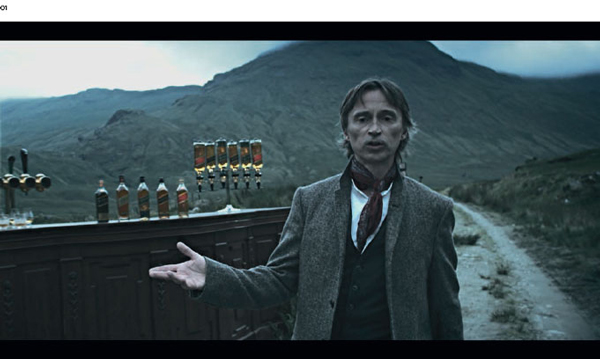
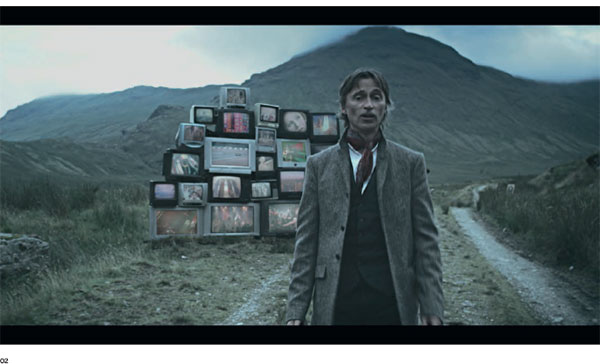
01-02 Actor Robert Carlyle stars in this film for Johnnie Walker. The ad began as an internal film for staff, but proved so popular when leaked online it was eventually released as a short film.
‘We plan and research and we don’t leave room for mistakes, but mistakes can be beautiful. Mistakes are where you get to new places. We don’t often put ourselves in a place where it might go wrong.’

03 BBH copywriter Justin Moore’s early plan of some of the objects that would appear during the course of Robert Carlyle’s walk.
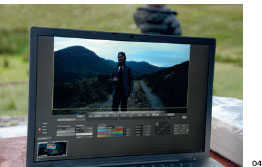
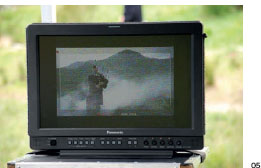
04-05 Images showing the recording of The Man Who Walked Around The World film.
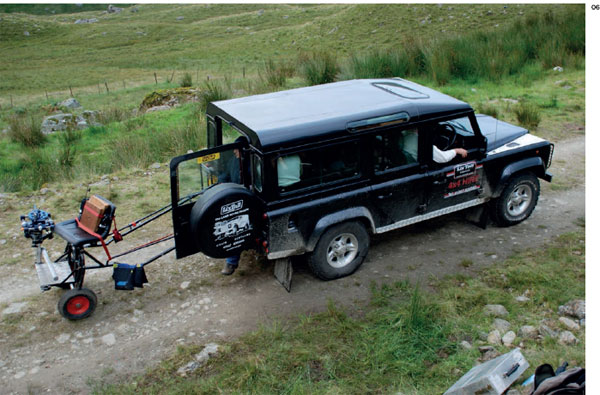

06-07 Photographs taken during the shoot for the film, showing the ‘rickshaw’ that held the camera, and various parts of the set that Robert Carlyle had to pass at specific points during the filming.
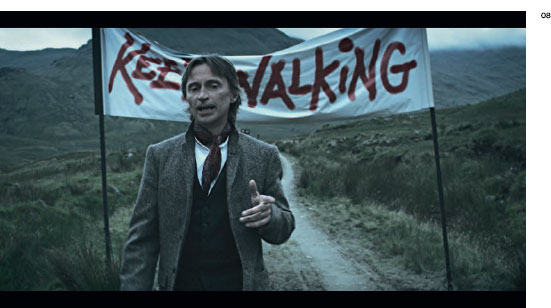
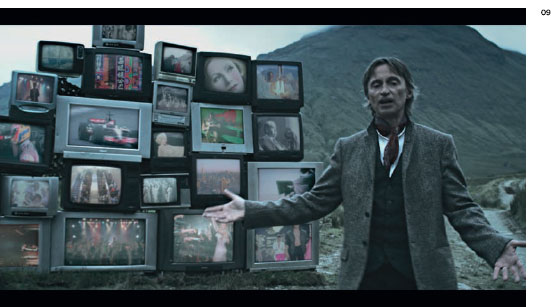

08-10 Stills from the finished film. Carlyle completed his performance in just one take, meaning that little postproduction was required on the film. The take that was finally used occurred at the end of the last day of filming, as the sun set, giving the film its steely grey look.
‘People love beautifully crafted stuff. They love to look at something where they know that the people who made it sweated blood to make it as brilliant as it could be.’
The team knew they needed an excellent actor to carry off such a wordy script in one take. The performance also required perfect timing, to ensure that certain props would be passed on the walk when relevant words in the script were spoken. Carlyle was their number-one choice. ‘I was on edge for weeks and weeks, saying, “if he doesn’t do it, it’s going to be shit, it’s got to be him”,’ remembers Moore. Carlyle’s agreement to be part of the project was therefore a great relief, and also confirmed to the creative team that they had written something special. At this stage, however, the original plan for the film to be just an internal film for Johnnie Walker staff remained in place.
The film was shot in three days in Scotland, near Loch Doine. The first day was for rehearsal, with two days reserved for shooting. ‘The biggest challenges were technical,’ says Rafn. ‘My producer, Steve Plesniak, and I did loads of prep. The moment we got the brief we went off to Hyde Park in London with an HDV camera and started walking it through. Steve would read and drop index cards with things like “cow” written on them while I staggered backwards with the camera. By doing this again and again we could work out the spacing between the props and areas where we might need more or less. We then transferred that process up to Scotland on the recce, so that by the time we were ready to shoot we were very well prepared and knew exactly what all the potential problems were from a technical point of view. In spite of all our preparation though, the things we couldn’t account for were things like midges. The whole crew had their jumpers pulled over their heads. This was okay for all of us behind camera, but it wasn’t really going to work for Robert, who somehow managed to deliver his lines, hit his marks and give an amazing performance while ignoring the multitude of midges swarming around his head.’
Other things went wrong on the shoot, including the rickshaw that was pulling the camera falling over, but the major obstacle the team faced was the one they had set for themselves – the need for the ad to be completed in one take. The first day of shooting resulted in no usable film, and the pressure remained throughout the second, and final, day. ‘We had nothing really until the last take on the last day, with light falling,’ says Moore. ‘We had one take that was alright, and another half a take, and we were wondering if we could trick it together. Post is good enough now… maybe there’s something we could do to stitch it together. It was the last take on the last day, with the light going from the sky – that’s why it looks so cool and steely, it went dark immediately afterwards – and he nailed it and everyone roared, literally cheered and roared and kissed each other, it was amazing. Then we went home.’ The film was polished in post-production, including Carlyle post-synching the vocals, but the team strived to keep the authenticity of the one take. ‘We wanted it to be authentic, to be honest,’ says Moore. ‘But it should look really lovely as well, it should be beautiful, it should be a joy to watch.’
The film reached the wider world by accident. Initially leaked online, it began to gain attention but was rapidly removed by the team. Eventually though, it was decided that it should have a broader life on the internet. ‘I think everyone realized that that’s the world now, that stuff cannot be put in a box and expected to stay there,’ says Moore. ‘It’s just how it goes; if people like stuff, they tell other people about it. We talk digitally, we have a whole existence in another place.… I’m really pleased, because you did feel a little sad that it was only ever going to be seen at sales conferences and by people who had the right log-in for the Johnnie Walker intranet.’
‘I was surprised by its popularity online,’ Moore continues, ‘because I thought it was a bit weighty and a bit wordy to live in that world. But I think that was why it was interesting as well, and it made me think that we need to think more smartly about what people want to watch. People love stories – that’s eternal and unchanging – and people love great performances. And actually, people love beautifully crafted stuff. They love to look at something where they know that the people who made it sweated blood to make it as brilliant as it could be.’
